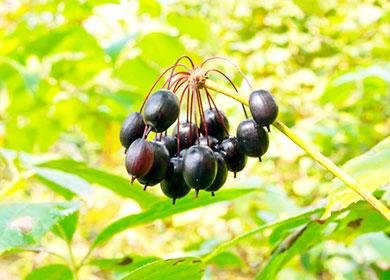The content of the article
Indications for the use of Eleutherococcus are similar to the recommendations for use ginseng. Therefore, plants are often equalized in their properties and characteristics of the impact on the body. But studies of recent years show that the Far Eastern culture has a number of unique features that allow it to be used as an adaptogenic and stimulating agent.
Features of Eleutherococcus spiny
Folk rumors gave this plant several unflattering names. It is called the bloody bush for bearing large black berries, which are considered poisonous. Another name is tepid, as the trunk of the plant is covered with numerous small spikes, and touching it means it hurts to prick your hand. But culture is much more harmless than is commonly believed, and its external features are associated with elementary protection from adverse external conditions.
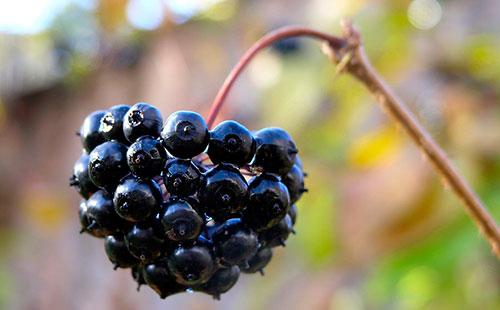
Description
The plant is part of the Eleutherococcus group, numbering about thirty species of small trees and shrubs. Prickly Eleutherococcus reaches a height of two - two and a half meters, less often grows to five meters.
The bush is sprawling, with a well-developed crown formed by numerous trunks. From one rhizome, up to twenty-five trunks can be grown, covered with tiny spines, directed horizontally and down. The presence of thorns throughout the trunk protects the culture from excessive moisture loss, so the shrub can calmly survive dry periods. A huge rhizome also helps in this. With a small height of the bush, its root can go in depth by thirty meters, reaching deep aquifers. Closer to the surface of the soil, a large rhizome spreads, consisting of numerous thin roots-appendages.
The surface of the trunks of Eleutherococcus is light gray. They are decorated with neat carved leaves, divided into segments. They are oval in shape, covered with thin setae at the top or completely bare. To accurately determine this type of plant, you can examine the lower part of the leaves. It is always covered with a reddish edge, concealing numerous veins.
From the second half of July until the onset of August, the bush blooms. It is covered with small umbrellas, consisting of miniature snow-white flowers. Umbrellas crown almost every twig, so the whole bush looks fluffy.
In September, the fruiting period begins. In place of umbrellas, spherical fruits are formed with a glossy, even skin. Inside they have five dense stones, the total diameter of the drupe - no more than ten millimeters. As they ripen, the fruits acquire a saturated black color, after which they dry out and fall off.

Geography and distribution
Prickly Eleutherococcus can be attributed to rare endemic species. It grows in limited areas in China, Korea and Japan.In Russia, its populations are recorded exclusively in the Far East. It grows on Sakhalin, in the Amur Region, Khabarovsk and Primorsky Territories.
Prefers moist areas of soil, but calmly tolerates the absence of ponds nearby. Therefore, it can be found both on well-lit mountainsides and in floodplains. The favorite place for the bush to grow is broad-leaved forest, especially cedar forests, where it forms dense thickets and forms an extensive undergrowth.
The ideal climatic conditions of the Far East allow the plant to grow freely. There is no threat of its extinction, despite the fact that annually procured raw materials for the manufacture of preparations Eleutherococcus. According to A.I. Schreter, author of a book on medicinal plants of the Far East, there are possibilities of harvesting several hundred tons of raw materials.
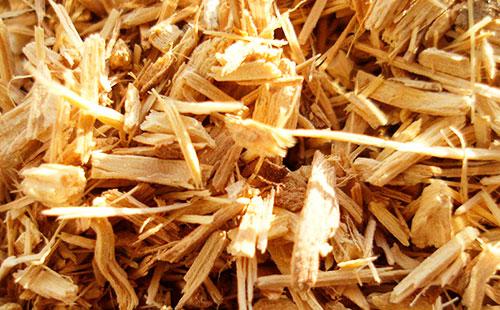
Collection and Harvesting
A separate region of growth does not allow large-scale harvesting of a medicinal plant throughout Russia. Therefore, in the central and southern regions, ready-made forms of the medicinal plant are used in tablets or tincture.
When self-harvesting should focus on the period of completion of fruiting crops. It is allowed to collect raw materials starting in the second half of September, when the fruits have fully ripened, and extracting part of the root system will not cause catastrophic damage to the bush.
The roots and rhizomes of the culture have medicinal value. Active compounds are also present in the leaves, but in this case the effect of eleutherococcus cannot be predicted, since their composition has been little studied.
The root system of the bushes is two-tiered. The main root goes deeper, and numerous adnexa are located almost on the surface. Harvest those roots that can be easily removed from the earth with its minimum breaking. They are dug up with a shovel, chopped off and quickly washed in cold water. For drying, they are laid out in attics under a metal roof or drying chambers are used, where the raw material reaches the necessary "maturity" at seventy to eighty degrees.
The dried root of Eleutherococcus is crushed, chopping into pieces no more than fifty centimeters in length. For storage, they are placed in linen bags and sent to a dry, well-ventilated place.
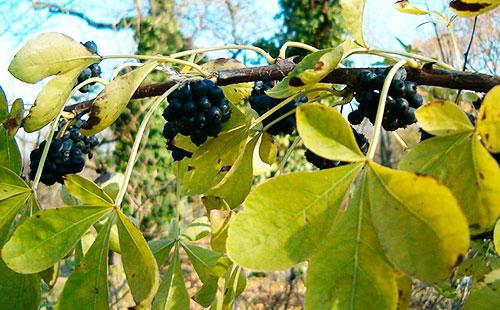
Composition and properties
The healing properties of eleutherococcus are not well understood. The first studies were carried out by specialists from the Far Eastern Branch of the Academy of Sciences of the Soviet Union. It was revealed that the roots and stems of the bushes contain substances similar in composition to coumarins, and the leaves contain flavanoids.
In the root part, the concentration of all components is higher than in other organs of the plant. The isolated substances were not previously found in other cultures, so they were named eleutherosides. There are seven such compounds.
The action of eleutherosides is different from the action of saponins contained in the ginseng root system. Therefore, it is not correct to equalize the effect of both plants, but they are similar in a number of properties.
- Excitation of the nervous system. The liquid extract of Eleutherococcus activates the central nervous system, and the effect occurs quickly, within a few minutes after administration and lasts up to four hours. It increases motor activity, the speed of development of reflexes.
- Increased availability. It has a stimulating effect in physical and mental overwork. It affects, first of all, the work of the brain, due to which mental performance increases.In this case, there is no subjective sensation of overexcitation, but the acuity of hearing and vision increases.
- Body adaptation. The plant is one of the most effective adaptogens that help the human body painlessly cope with the effects of stress caused by negative or unusual environmental conditions.
- Strengthening the immune system. The ability of the active components of Eleutherococcus to enhance the body's immune response to external aggressive factors, in particular, the viral, pathogenic environment, has been revealed. According to the author of the book on medicinal plants of the USSR V.Popov, the indications of Eleutherococcus are especially oriented to people living in areas with high levels of radiation pollution.
- Decrease in sugar level. Tests were conducted in which plant extract was used to treat mild diabetes. It was found that the use of tincture of the plant reduces blood sugar to normal levels and eliminates the need for additional insulin.
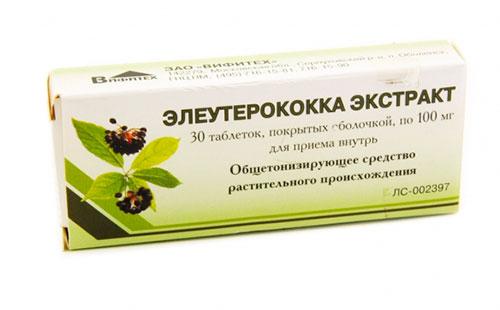
The use of Eleutherococcus
The instruction for the use of Eleutherococcus in tablets, drops allows us to consider it as an adjuvant for mental illness, to increase efficiency during mental workouts, to ensure the body's resistance to adverse environmental conditions and stress.
The first samples of medical use were conducted by employees of the Tomsk Medical Institute. The tincture was included in the treatment program for patients with hypochondria. Prior to the start of therapy, they were offered exclusively sedative and restorative drugs, because of which patients felt depressed, experienced lethargy, lack of tone.
After the start of taking the drug, their condition improved. Doctors found the disappearance of specific complaints for the underlying disease, observed activity, normalization of the nervous system of patients.
Adaptation of the body of an elderly person
An important study that allowed us to expand the question of why eleutherococcus can be used in medicine, was conducted by Soviet scientists in the eighties. The tool was considered in the context of supporting the body of the elderly, as an adaptogen and a regulator of the cardiovascular system.
The trial involved elderly women aged fifty-three to seventy-two years. Every day they received a herbal remedy in drops half an hour before meals. The dosage was thirty drops twice a day, the treatment took two weeks. Additionally, women went in for sports - light fitness, according to the level of load corresponding to age.
The subjects noted a general improvement in well-being, vigor, and the absence of fatigue after playing sports. Efficiency increased, while the performance of the heart and blood vessels returned to normal; in twenty percent of the subjects, blood pressure did not change.
Increased immunity in childhood
The instructions on how to take Eleutherococcus, it is noted that the tool is not allowed for use in children under twelve years of age. The basis for this recommendation is the lack of clinical trials that have made it possible to trace how the herbal preparation actually affects the child's body.
In 2011, experts from the Amur State Medical Academy conducted a study in which eleutherococcus was offered to toddlers.The study involved twenty children in the nursery group of a kindergarten, the average age of which was 2.1 years. The plant extract was offered to them in drops diluted with water, at the rate of one drop for one year of life once a day. The test duration was twenty eight days.
The study noted an increase in attendance by children of the kindergarten in the autumn-winter period. The number of regularly ill babies decreased by twenty-five percent. At the same time, the number of children attending kindergarten constantly, without passes, increased by twenty-five percent.
Additionally, a study was conducted of the microflora of the oral cavity and nasopharynx of babies in order to identify changes in its composition. There was a decrease in the number of poorly differentiated epithelial cells in the mouth, which allowed the organizers of the study to conclude that local immunity was improved and children's organisms had better resistance to viral infections.
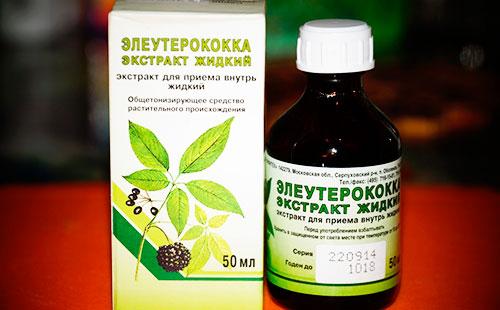
Improving vital signs in oncology
There are data on clinical studies in which eleutherococcus extract has been used in the treatment of cancer. The first experiments on mice were carried out in the late sixties by Professor K.V. Yaremenko. He noted that during treatment with Eleutherococcus, tumor cells inoculated in experimental animals were significantly worse.
Researcher N.P. Napalkov pointed out that preliminary herbal therapy slowed down the formation of neoplasms in rats that received carcinogenic drugs. The antiestasizing properties of the plant extract and its pronounced antioxidant effect were noted.
Subsequently, studies were conducted using other drugs used in chemotherapy. A decrease in negative side effects of deep radiotherapy, thiofasfamide was noted. A herbal remedy improves blood counts and allows you to increase the dosage of the main chemotherapy drug to achieve an early result. This conclusion was made by a practicing oncologist, E. B. Poleva.
Dosage and Advice
The herbal remedy has a stimulating and tonic effect. It is recommended to take it under the following conditions:
- physical exhaustion - Recommended for athletes and people engaged in physical labor to normalize vitality, increase efficiency;
- emotional overwork - when engaging in active mental labor, the tool normalizes the emotional background, gives vivacity, energy;
- exposure to stress factors- the drug increases the body's resistance to negative environmental influences of a chemical, viral nature, minimizes the effects of stress;
- decreased immunity - increases the body's resistance to viral infections;
- hypotension - taking the drug raises the pressure to normal;
- elderly age- It is recommended to use to increase the vitality of the elderly, reduce fatigue, normalize pressure for men and women.
Contraindications Eleutherococcus - hypertension due to the risk of a dangerous increase in pressure. Do not use it during pregnancy and during lactation. It is not allowed to use during an acute respiratory disease, with a heart attack, arrhythmia. May worsen the condition in neurasthenic disorders with increased excitability and activity of the patient.
In the matter of how to take Eleutherococcus in tablets and drops, it is important to consider the age and condition of the patient.
- Liquid extract. Thirty drops twice daily. It is recommended to monitor well-being and reduce the dosage in case of anxiety, irritability, insomnia.In childhood, it is forbidden to take the drug, but a study by Russian scientists showed the advisability of treating children with eleutherococcus with a dosage of one drop for one year of life once a day.
- Pills. One hundred and two hundred milligrams at a time twice daily. The dosage is set individually according to the state of health of the patient. The dosage form is not used in childhood.
Take the drug course for twenty-five to thirty days. Then you need a break for ten days and the reception can be continued. There is information about the safety of long-term use. During the treatment of cancer patients, admission was carried out for a year and a half with regular breaks of ten days.
Cooking tincture
If it is possible to prepare tincture of Eleutherococcus yourself, use the following recipe.
- Finely chop the roots, use fifty grams of raw material.
- Place in a glass container.
- Pour in five hundred milliliters of vodka.
- Cork, put in a dark place for seven days.
- Shake the tincture daily.
Method of using eleutherococcus in the form of homemade tincture - one teaspoon or dessert spoon twice a day before meals. The course of treatment is one month.
Eleutherococcus is a medicinal plant with adaptogenic properties. It increases the body's resistance to stress, infectious and viral environments. Reception of tincture or tablets gives vigor, energy, reduces fatigue during sports, mental work. The tool is recommended in old age, in the treatment of hypotension, diabetes mellitus, oncology. Admission to pediatric therapy is not recommended, but there is evidence of its successful use to increase the seasonal immunity of toddlers.
